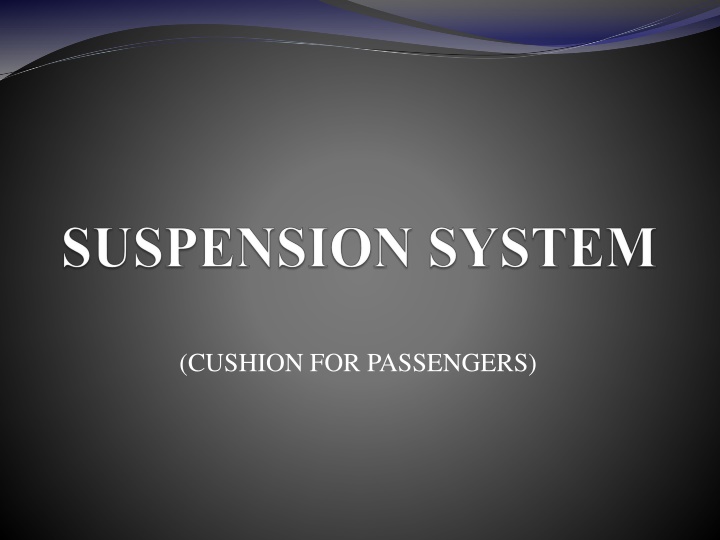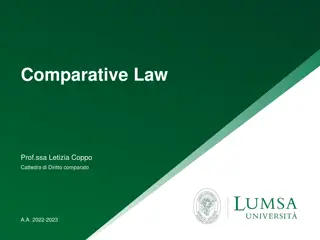
Guide to Suspension Systems: Importance, Principles & Working
Learn about the role of suspension systems in vehicles, the principles behind their design, and how they work to provide a smoother ride, protect the vehicle, and maintain control. Explore the definitions of sprung and unsprung mass, and understand the key functions of this crucial automotive component.
Download Presentation

Please find below an Image/Link to download the presentation.
The content on the website is provided AS IS for your information and personal use only. It may not be sold, licensed, or shared on other websites without obtaining consent from the author. If you encounter any issues during the download, it is possible that the publisher has removed the file from their server.
You are allowed to download the files provided on this website for personal or commercial use, subject to the condition that they are used lawfully. All files are the property of their respective owners.
The content on the website is provided AS IS for your information and personal use only. It may not be sold, licensed, or shared on other websites without obtaining consent from the author.
E N D
Presentation Transcript
INTRODUCTION Suspension system is the term given to the system of springs, shock absorbers and linkages that connects a vehicle to its wheels . It is basically cushion for passengers protects the luggage or any cargo and also itself from damage and wear. Sir William Brush is the father of suspension system in automobiles.
ROLE OF SUSPENSION SYSTEM The main role of suspension system are as follows: It supports the weight of vehicle . Provides smoother ride for the driver and passengers i.e. acts as cushion. Protects your vehicle from damage and wear . It also plays a critical role in maintaining self driving conditions. It also keeps the wheels pressed firmly to the ground for traction . It isolates the body from road shocks and vibrations which would otherwise be transferred to the passengers and load.
PRINCIPLE OF SUSPENSION Principle :-When a tire hits an obstruction, there is a reaction force. The size of this reaction force depends on the unsprung mass at each wheel assembly. In general, the larger the ratio of sprung weight to unsprung weight, the less the body and vehicle occupants are affected by bumps, dips, and other surface imperfections such as small bridges. A large sprung weight to unsprung weight ratio can also impact vehicle control.
DEFINITIONS OF SPRUNG &UNSPRUNG MASS Sprung mass :-Sprung mass (weight) refers to vehicle parts supported on the suspension system, such as the body, frame, engine, the internal components, passengers, and cargo. Unsprung mass :- Unsprung mass refers to the components that follow the road contours, such as wheels, tires,brake assemblies, and any part of the steering and suspension not supported by the springs.
WORKING OF SUSPENSION SYSTEM No road is perfectly flat i.e. without irregularities. Even a freshly paved highways have subtle imperfections that can be interact with vehicle s wheels. These are the imperfections that apply forces on wheels. According to Newton s law of motion all forces have both magnitude and direction. A bump in the road causes the wheel to move up and down perpendicular to the road surface. The magnitude of course ,depends on whether the wheel is striking a giant bump or a tiny speck. Thus, either the wheel experiences a vertical acceleration as it passes over an imperfection.
PARTS OF TYPICAL SUSPENSION The suspension of a car is actually part of the chassis, which comprises all of the important systems located beneath the car's body. These system include : Frame Suspension system Steering system Tires or Wheels
The basic components of car suspension system shown by figure :
COMPONENTS OF ANY SUSPENSION There are three fundamental components of any suspension system . Springs Dampers Anti sway bars
SPRINGS Coil spring Leaf springs Air springs
DAMPERS Three types:- Shock Absorbers:-
Anti-sway Bars:- Anti-sway bars (also known as anti- roll bars) are used along with shock absorbers or struts to give a moving automobile stability. An anti-sway bar is a metal rod that spans the entire effectively joins each side of the together. additional axle and suspension
TYPES OF SUSPENSION FRONT REAR NON NON INDEPENDENT INDEPENDENT INDEPENDENT INDEPENDENT
FIGURES SHOW DIFFERENCE BETWEEN INDEPENDENT AND NON INDEPENDENT SUSPENSIONS
ADVANTAGES Comfort to passengers Good handling Shields the vehicle from damage Increases life of vehicle Keeps the tires pressed firmly to ground
SPECIALISED SUSPENSIONS FORMULA ONE MULTI LINK SUSPENSION
MORDERN TECHNOLOGY Hydraulic fluid and air suspension Electronic and active suspensions
CONCLUSION From the whole discussion in suspension system, I observe that suspension system is like a white blood cell .As white blood cell provides energy to our body to fight against diseases or viruses which try to destroy or try to decrease our life ,in the similar way suspension system provides the energy to a vehicle to protect itself from damaging, increasing life of the vehicle ,increases the handing,increases comfort of passengers and many more. So, according to me if you remove the suspension system, then you feel like in bull- cart in Audi , Mercedes types luxurious cars. The only difference is speed. So, the scope of Suspension System is Too Bright.

![❤[PDF]⚡ Civil War Talks: Further Reminiscences of George S. Bernard and His Fel](/thumb/20551/pdf-civil-war-talks-further-reminiscences-of-george-s-bernard-and-his-fel.jpg)




















